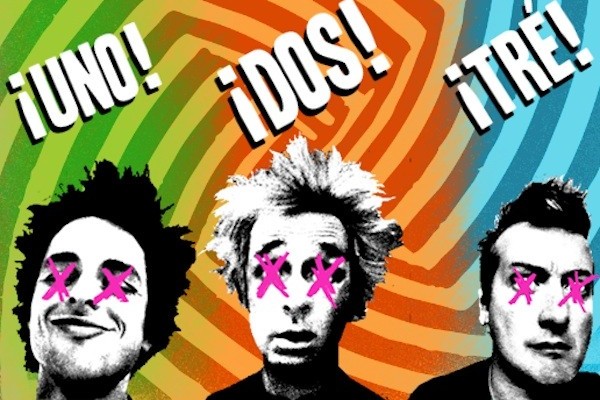Words by Bill San Antonio
Now that the dust has settled on the final installment of Green Day’s album trilogy, as ¡Tré‘s release date was pushed back in time for the holiday season, it’s pretty obvious that the pop-punk trio added some very solid material to their legendary catalogue.
Unfortunately, the best moments of ¡Uno!, ¡Dos!, and ¡Tré! were often bogged down by chunks of bland, repetitive material that would better serve as b-sides or ideas left in the notebook for another day in the studio. The trilogy’s biggest fault was that it was only good, not great.
But what if Green Day had released only one record, putting together the very best that the three albums offered? The answer is simple: The album would serve as the follow-up to 2004’s American Idiot that fans truly deserved, rather than the one they needed after the band took five years to release 21st Century Breakdown.
Leaving nothing to fantasy, I played Armchair Producer and constructed a list of the 12 trilogy songs that best utilize the power-pop/garage style teased during production, best remind us of the band’s classics, and are most likely to crack the set list for the inevitable 2037 50th Anniversary Tour:
1. Nuclear Family— The first song on the first album of Green Day’s trilogy had to showcase their new sound in a way that would keep their fans engaged for the duration of three full-length records while giving fans alienated by the previous concept albums a reason to return to the band they once loved. “Nuclear Family” shatters those expectations right from the opening downbeat.
2. Kill the DJ—For all the time singer Billie Joe Armstrong spends criticizing the rampant EDM culture and establishing the violent metaphor that is doing away with it completely, the rest of the band does an even better job, ironically, orchestrating an undeniably catchy dance song.
3. Fell for You—“Fell For You” feels like a nostalgic trip back to the soda shop, the kind of song you’d sing to your best girl after giving her your letterman jacket and asking her to the school dance. It’s a sweet and simple love song perfectly executed by a band that’s proven—with “Redundant,” off 1995’s Nimrod, and “Church on Sunday,” off 2000’s Warning—it can write a sweet and simple love song that packs a very powerful sound.
4. Loss of Control—The song’s roots are well-documented throughout the band’s timeline, from “Letterbomb,” off American Idiot, back to “Nice Guys Finish Last,” off Nimrod, and so forth. The only differences? White’s lead guitar parts give “Loss of Control” a timelier and more contemporary attitude, and Armstrong’s triple vocal track near the end of the song—with the rest of the band at a standstill— tests the adage that you can’t teach an old dog new tricks.
5. Lazy Bones—Tre Cool’s complementing snare and bass drum pounding leads Armstrong’s crooning toward a tidal wave of a chorus, as both guitars, with heavy feedback, fill in alongside crashing cymbals and howling backing vocal. “Lazy Bones” starts small and gets very big very fast.
6. Makeout Party—The best Green Day songs are sexually-charged bursts rebellious energy. “Makeout Party” meets this criterion and then some, implementing the return of Armstrong’s classic staccato lyrical delivery heard mostly on ’90s Green Day tracks and a pair of free-range solos from guitarist Jason White and bassist Mike Dirnt.
7. Stray Heart—Dirnt’s trippy basslines have always been the perfect backbone for Armstrong’s simple-but-abrasive chord progressions over the years. Though mostly underused throughout the trilogy, Dirnt is as integral as ever on “Stray Heart,” steering the second of three regretful songs about mishandled romantic opportunities toward freewheeling choruses that are some of the most emotional bits of any of the three records.
8. Amy—While an Amy Winehouse tribute might seem an odd choice from a punk band, Armstrong’s own struggles with sobriety add another layer of emotion to an already haunting track. Rightfully so, as it’s just Armstrong, his guitar, and some vocal feedback mourning the gone-too-soon R&B princess.
9. Brutal Love—The opener of the trilogy’s final installment dials back the pace, throwing a wind section and ragtime keys into the caldron for a very E Street Band approach to demonstrate Green Day’s command in composing pompous, theatrical rock operas.
10. Amanda—Clocking in at 2:28, “Amanda” is among the shortest songs of the trilogy. Everything about it is simple, with the musical arrangement centered around on highlighting Armstrong’s vocal melody—right down to White’s soloing—but it is a rocker and a romper and one of the most fun tracks to listen to over and over again.
11. Dirty Rotten Bastards—The most ambitious song to make the list, “Dirty Rotten Bastards” improves on the multi-part epics heard on American Idiot. There are fewer parts this time around, but the transitions aren’t as well-defined as “Jesus of Suburbia” and “Homecoming.” Opening as a belligerent Irish drinking song, “Dirty Rotten Bastards” segues into early-era Green Day skater punk and slows to something in-between by song’s end.
12. 99 Revolutions—While the Occupy Wall Street movement may have died down considerably since it exploded in public consciousness in late 2011, “99 Revolutions” is as strong an anthem as the movement may ever get and inspires to continue the fight against corruption and social injustice of all kinds.
www.greenday.com
TheWaster.com | Trilogy
01.01.13



